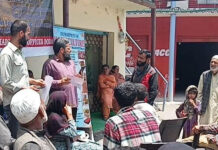Radhika Ramaseshan
WINTER is here and Manipur, like other states, is bracing itself for the chill. The discomfort is more acute for over 50,000 inhabitants of relief camps who were displaced by the ethnic violence that started in May. The year is about to end but the arson, assaults and killings carry on unabated. A solution, which must necessarily be initiated by the Centre, is perceptibly not in the works. Indeed, call it the tyranny of geography or cynical expediency, the Manipur crisis does not figure on Delhi’s radar.
To all intents and purposes, Manipur has faded from the political establishment’s collective consciousness as ‘larger’ issues preoccupy its time and attention, not the least being the ongoing state elections. Interestingly, one of the poll-bound states, which voted on November 7, shares a border, history and ethnicity with Manipur, a fact that the ruling BJP dispensation cannot ignore. That’s Mizoram, which has a Mizo National Front (MNF) Government with Zoramthanga as the Chief Minister. The MNF is an ally of the BJP, but the parties work separately through an opaque power-sharing arrangement.
Zoramthanga refused to share the dais with Prime Minister Narendra Modi when the latter was set to launch his Mizoram campaign on October 30. The CM cited the desecration of churches in Manipur as the main reason, which to him was unjustifiable in a Christian-majority state like his. Additionally, he turned down the Centre’s directive to seek the biometrics of the refugees who fled Myanmar’s military junta and sought shelter in Mizoram. PM Modi cried off his campaign plan.
Congress leader Rahul Gandhi alluded to the Manipur occurrences while speaking in Mizoram and said, “The idea of Manipur has been destroyed by the BJP. It is no longer a state, but two states.” He accused the PM of not sparing time to visit the state. The Opposition was animated in the first throes of the conflict, but has since not forced a significant intervention that could lead towards some kind of a closure. For a state measuring 22,327 square km, Manipur bristles with innumerable contradictions that have etched deep faultiness across the terrain running through Imphal Valley and the hill districts. The six-month-old strife has pitted the Meiteis, who are not tribal, against the Kuki-Zomi tribe. To put events in perspective, a recap of the demography is instructive. The Meiteis are largely Vaishnav Hindus who occupy a smaller portion (2,238 sq km) of the total area in the Valley, while the Kuki-Zomi, who are Christians, live in 20,089 square km of the hills with the Naga tribes, with whom they share a working relationship. The Meiteis account for 53 per cent of Manipur’s population, while the Kuki-Zomi and Nagas make up 40 per cent. The more populous Meiteis dominate Manipur’s political and administrative circles and call the shots.
However, their sense of insecurity about the Kuki-Zomi stems from the latter’s Scheduled Tribe status that facilitated a larger representation in education and government jobs and mobility from the hills to the plains.
If power distribution is a major source of friction, the other causes are land ownership, for which the Meiteis, who own a smaller proportion, feel short-changed, and cultural identity. These are issues that cannot be approached as mere law and order challenges; they require a political enterprise supported by a near-perfect understanding between the Centre and the state. It seems like an impossible call, given that through the decades, Delhi has treated north-eastern states like its serfs. The statistics are self-revelatory of how intractable the situation is. The data presented by IK Muivah, Inspector General of Police (Operation), at a press conference in September put the deaths at 175 (activists maintain that the figure has since shot up), the seriously injured at 1,108, disappearances at 32 and arson cases at 5,172, with 4,786 homes gutted. Additionally, the sectarian violence saw 254 churches and 132 temples vandalised and over 4,000 arms, including 400 bombs, were looted from state armouries. Over 70,000 people were displaced from their homes. Of the homeless, a majority are Kuki-Zomi, who, by overall reckoning, bore the brunt of the violence. Many are reluctant to term it a conflict anymore due to the lack of equivalence in casualties. Indeed, the displaced have said they will not celebrate Christmas. However, the desperation to seek an end — or at least a remission — propelled a 10-party delegation in November to beseech Governor Anusuiya Uikey to facilitate a meeting with the PM, calling him their “only hope”, despite the Centre’s studied indifference but for a mention in PM Modi’s reply to a no-confidence motion against the government in August.
While CM N Biren Singh is entrenched in his chair, the question arising is: does politics alone drive governance? The common belief is that Singh, a Meitei, consolidated his and the BJP’s base among the Valley’s Hindus whose votes are sufficient to secure another term for both. In fortifying his hold over the Meiteis, Singh was accused of overt partisanship. For example, while the government housed the uprooted Meiteis in alternative shelters, there was no effort to rehabilitate Kuki-Zomi, who subsisted on the barest minimum in the relief camps. Of the over 140 Kuki-Zomi killed, only 32 were buried. The rest of the bodies lie in morgues as the families implore the authorities to return the remains. The CM’s across-the-board labelling of the Kuki-Zomi as “illegal immigrants” gave a fig leaf to him and his administration to avoid visiting the camps. It also served as a dog whistle to civilians to target the victims with even greater impunity.
When an agreement was reached to return the remains, the Meira Paibis, a women’s movement ‘committed’ to defending rights, stood against the move. Civilians (read Meiteis) have been empowered so immeasurably that the Manipur police were perceived as an extension of the community, while the Assam Rifles was viewed askance because it was seen as ‘empathetic’ to the Kuki-Zomi. Who will police Manipur? Patricia Mukhim, Editor of The Shillong Times, asked in a recent piece: “And what’s the point in having over 40,000 boots on the ground that are essentially sent with their hands tied?” Is it a point of no return?




























